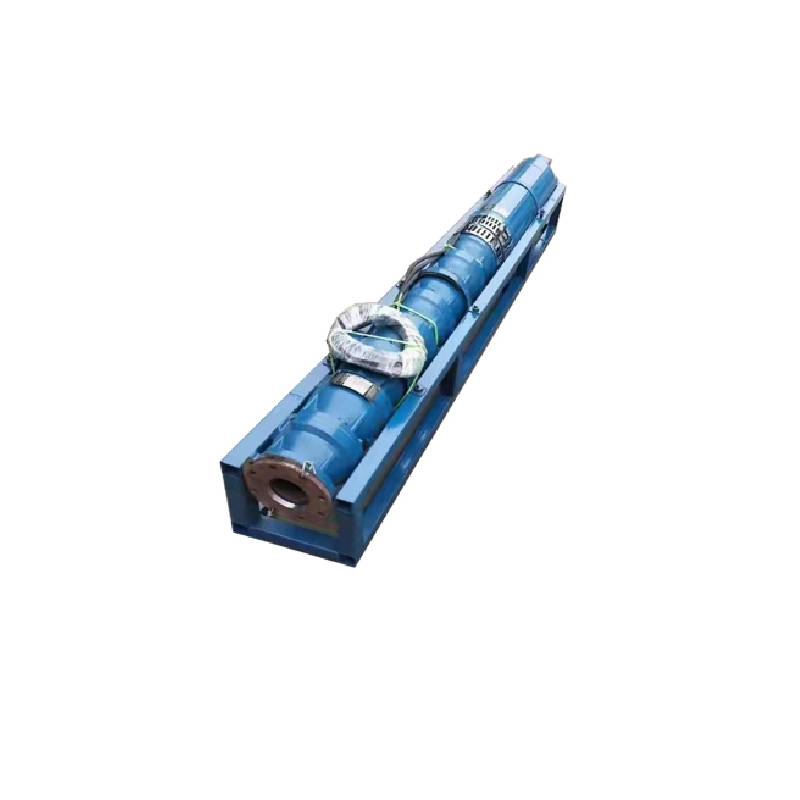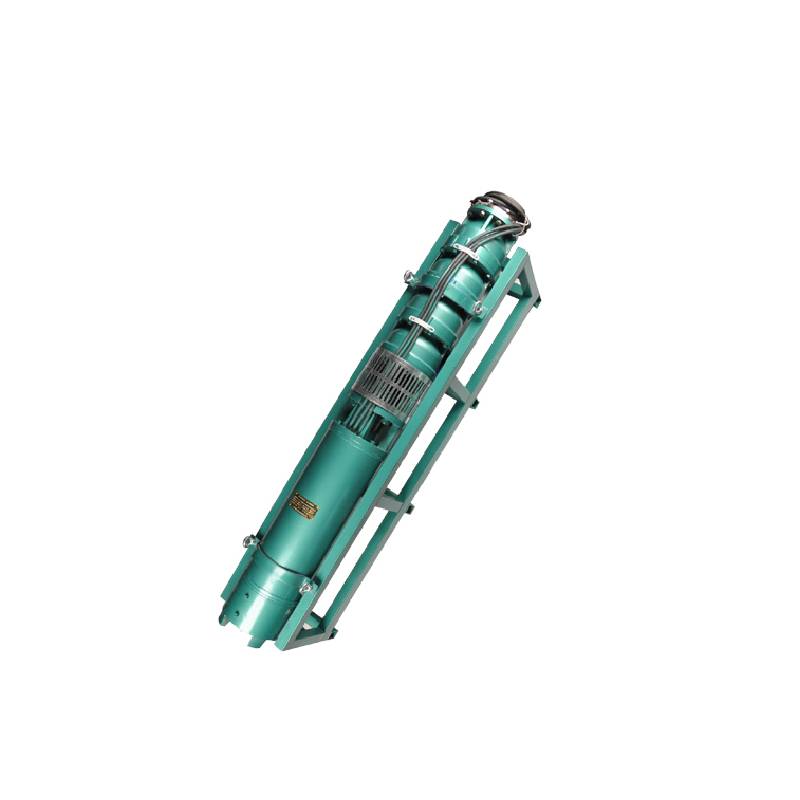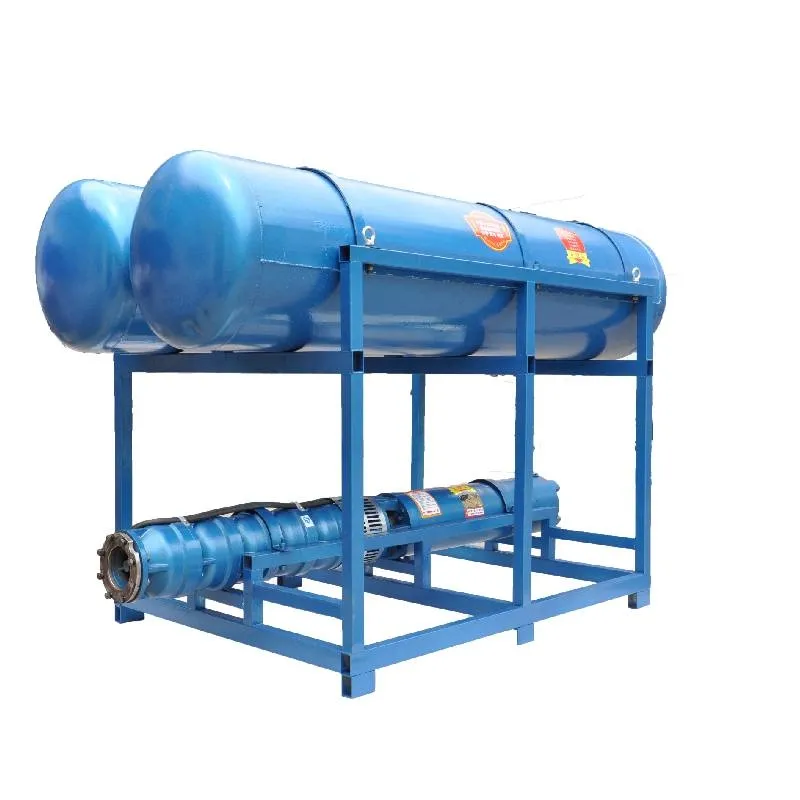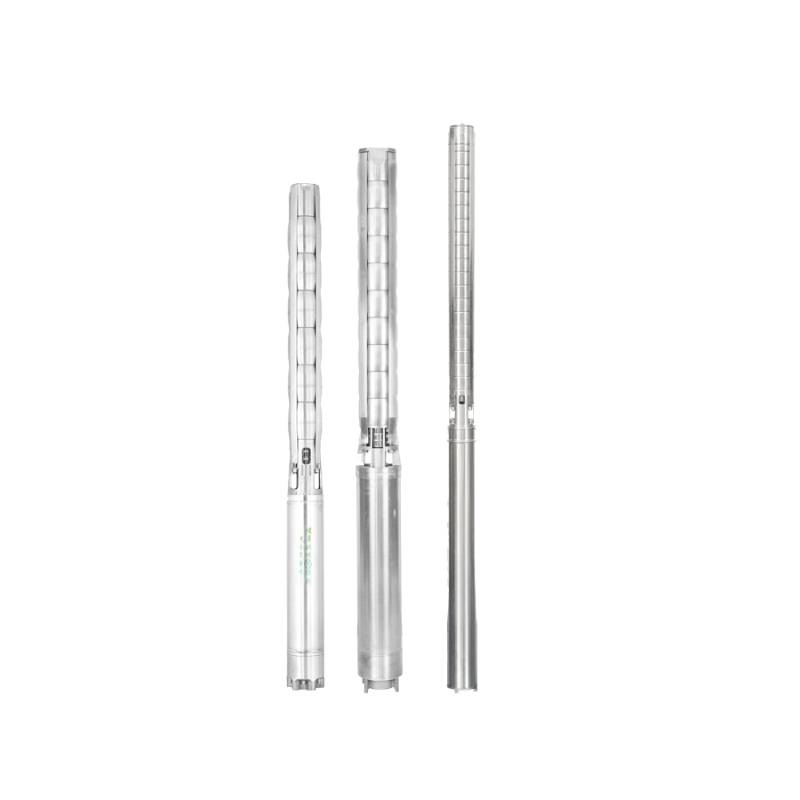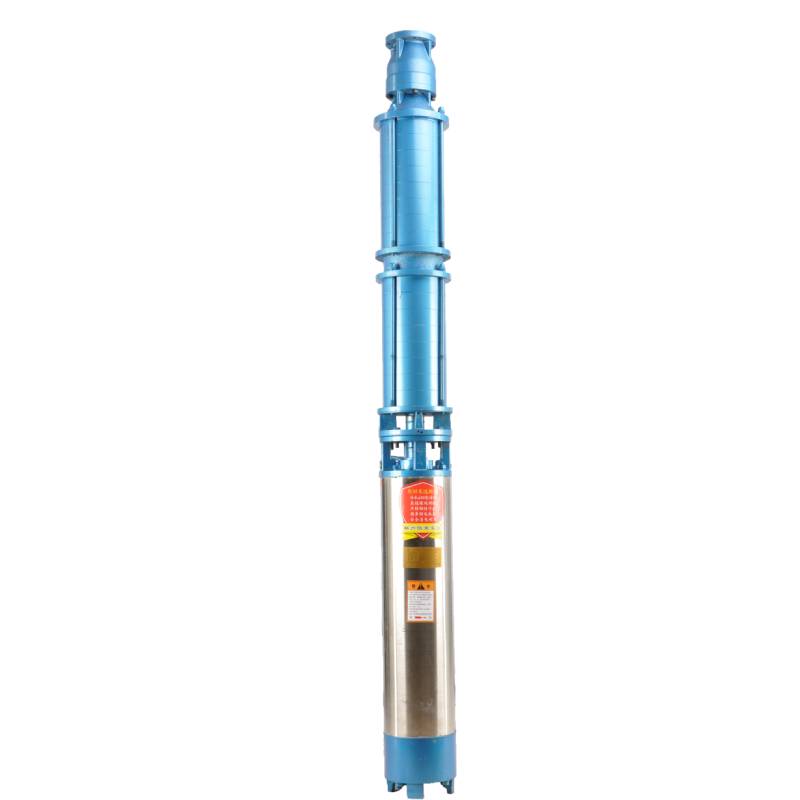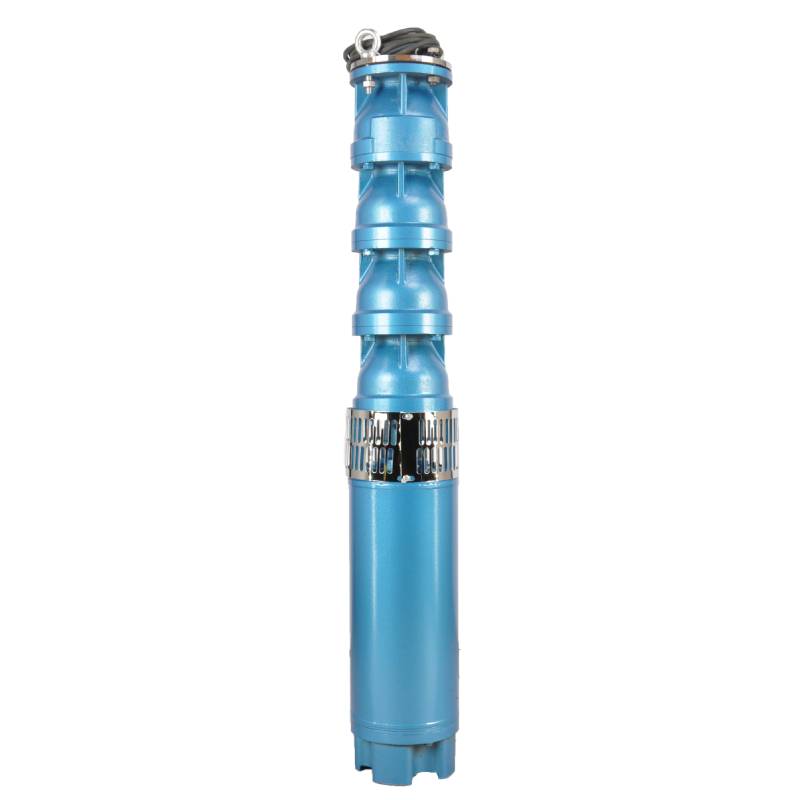QJP series special fountain pump is a special fountain pump developed by our factory. The pump motor core is made of high quality cold rolled silicon steel, which makes the pump more efficient, has good magnetic conductivity, and does not produce heat when starting frequently. The two ends of the motor rotor are covered with alloy copper sleeve as lubricant, using water. Stainless steel sleeves replace ball bearings, avoiding the problem of easy rust of ball bearings and the problem of motor burning due to lack of oil wear. It is very suitable for music fountain, all models can be used horizontally.
This product uses three-phase AC 380V power supply (tolerance + 5%), 50HZ frequency (tolerance + 1%); the applicable water quality conditions for water temperature is not higher than 20 °C, solid impurities content (mass ratio) is not more than 0.01%, pH value (pH) is 6.5-8.5, hydrogen sulfide content is not more than 1.5mg/L, chloride ion content is not more than 400mg/L. The motor adopts closed or water sealed wet structure, before use must be filled with clean water to prevent virtual filled, and then tighten the water injection and air exhaust bolts, otherwise not to use. Submersible pump must be completely immersed in water to work, immersion depth shall not exceed 70 meters, the distance between the bottom of the submersible pump and the bottom of the well shall not be less than 3 meters. The water in the well should be able to meet the water output and continuous operation of the submersible pump, the water output of the pump should be controlled at 0.7-1.2 times the rated flow. The well should be kept vertical, the submersible pump can not be used horizontally or overturned, only vertical installation. The submersible pump must be equipped with cables as required, and equipped with external overload protection device. The pump is strictly prohibited from no water load test.
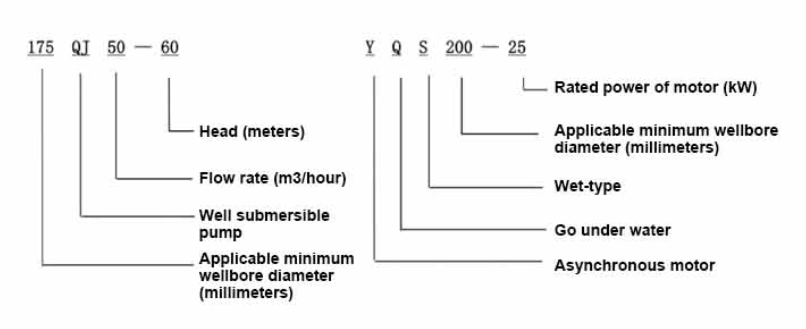
| Modelo | Fluxo (m3/h) | Cabeça (m) |
Velocidade de rotação (mudança/ponto) |
Bomba d'água (%) | Tomada diâmetro (milímetros) |
Bem aplicável diâmetro (mm) |
Avaliado power(KW) |
Avaliado tensão (V) |
Avaliado corrente (A) |
Eficiência motora (%) | power factorcosφ | Unidade Tamanho máximo radial (mm) |
Observação | |||||||||
| 200QJ20-40 | 20 | 40 | 2850 | 66 | 50 | 200acima | 4 | 380 | 10.1 | 76.0 | 0.79 | 184 | ||||||||||
| 200QJ20-54 | 54 | 5.5 | 13.6 | 77.0 | 0.8 | |||||||||||||||||
| 200QJ20-81 | 81 | 7.5 | 18.0 | 78.0 | 0.81 | |||||||||||||||||
| 200QJ20-93 | 93 | 9.2 | 21.7 | 78.5 | 0.82 | |||||||||||||||||
| 200QJ20-108 | 108 | 11 | 25.8 | 79.0 | 0.82 | |||||||||||||||||
| 200QJ20-121 | 121 | 13 | 29.8 | 80.0 | 0.83 | |||||||||||||||||
| 200QJ20-148 | 148 | 15 | 33.9 | 81.0 | 0.83 | |||||||||||||||||
| 200QJ20-175 | 175 | 18.5 | 41.6 | 81.5 | 0.83 | |||||||||||||||||
| 200QJ20-202 | 202 | 22 | 48.2 | 82.5 | 0.84 | |||||||||||||||||
| 200QJ20-243 | 243 | 25 | 54.5 | 83.0 | 0.84 | |||||||||||||||||
| 200QJ20-270 | 270 | 30 | 65.4 | 83.0 | 0.84 | |||||||||||||||||
| 200QJ20-360 | 360 | 37 | 79.7 | 84.0 | 0.84 | |||||||||||||||||
| 200QJ20-442 | 442 | 45 | 96.9 | 84.0 | 0.84 | |||||||||||||||||
| 200QJ25-28 | 25 | 28 | 2850 | 68 | 65 | 200acima | 4 | 380 | 10.1 | 76.0 | 0.79 | 184 | ||||||||||
| 200QJ25-42 | 42 | 5.5 | 13.6 | 77.0 | 0.8 | |||||||||||||||||
| 200QJ25-56 | 56 | 7.5 | 18.0 | 78.0 | 0.81 | |||||||||||||||||
| 200QJ25-70 | 70 | 9.2 | 21.7 | 78.5 | 0.82 | |||||||||||||||||
| 200QJ25-98 | 98 | 11 | 25.8 | 79.0 | 0.82 | |||||||||||||||||
| 200QJ25-112 | 25 | 112 | 2850 | 68 | 65 | 200acima | 13 | 380 | 29.8 | 80.0 | 0.83 | 184 | ||||||||||
| 200QJ25-126 | 126 | 15 | 33.9 | 81.0 | 0.83 | |||||||||||||||||
| 200QJ25-154 | 154 | 18.5 | 41.6 | 81.5 | 0.83 | |||||||||||||||||
| 200QJ25-182 | 182 | 22 | 48.2 | 82.5 | 0.84 | |||||||||||||||||
| 200QJ25-210 | 210 | 25 | 54.5 | 83.0 | 0.84 | |||||||||||||||||
| 200QJ25-252 | 252 | 30 | 65.4 | 83.0 | 0.84 | |||||||||||||||||
| 200QJ25-308 | 308 | 37 | 79.7 | 84.0 | 0.84 | |||||||||||||||||
| 200QJ25-378 | 378 | 45 | 96.9 | 84.0 | 0.84 | |||||||||||||||||
| 200QJ32-26 | 32 | 26 | 2850 | 70 | 80 | 200acima | 4 | 380 | 10.1 | 76.0 | 0.79 | 184 | ||||||||||
| 200QJ32-39 | 39 | 5.5 | 13.6 | 77.0 | 0.8 | |||||||||||||||||
| 200QJ32-52 | 52 | 7.5 | 18.0 | 78.0 | 0.81 | |||||||||||||||||
| 200QJ32-65 | 65 | 9.2 | 21.7 | 78.5 | 0.82 | |||||||||||||||||
| 200QJ32-78 | 78 | 11 | 25.8 | 79.0 | 0.82 | |||||||||||||||||
| 200QJ32-91 | 91 | 13 | 29.8 | 80.0 | 0.83 | |||||||||||||||||
| 200QJ32-104 | 104 | 15 | 33.9 | 81.0 | 0.83 | |||||||||||||||||
| 200QJ32-130 | 130 | 18.5 | 41.6 | 81.5 | 0.83 | |||||||||||||||||
| 200QJ32-143 | 143 | 22 | 48.2 | 82.5 | 0.84 | |||||||||||||||||
| 200QJ32-169 | 169 | 25 | 54.5 | 83.0 | 0.84 | |||||||||||||||||
| 200QJ32-195 | 195 | 30 | 65.4 | 83.0 | 0.84 | |||||||||||||||||
| 200QJ32-247 | 247 | 37 | 79.7 | 84.0 | 0.84 | |||||||||||||||||
| 200QJ32-299 | 299 | 45 | 96.9 | 84.0 | 0.84 | |||||||||||||||||
| 200QJ40-26 | 40 | 26 | 2850 | 72 | 80 | 200acima | 5.5 | 380 | 13.6 | 77.0 | 0.8 | 184 | ||||||||||
| 200QJ40-39 | 39 | 7.5 | 18.0 | 78.0 | 0.81 | |||||||||||||||||
| 200QJ40-52 | 52 | 9.2 | 21.7 | 78.5 | 0.82 | |||||||||||||||||
| 200QJ40-65 | 65 | 11 | 25.8 | 79.0 | 0.82 | |||||||||||||||||
| 200QJ40-78 | 78 | 15 | 33.9 | 81.0 | 0.83 | |||||||||||||||||
| 200QJ40-104 | 104 | 18.5 | 41.6 | 81.5 | 0.83 | |||||||||||||||||
| 200QJ40-117 | 117 | 22 | 48.2 | 82.5 | 0.84 | |||||||||||||||||
| 200QJ40-143 | 143 | 25 | 54.5 | 83.0 | 0.84 | |||||||||||||||||
| 200QJ40-169 | 169 | 30 | 65.4 | 83.0 | 0.84 | |||||||||||||||||
| 200QJ40-208 | 208 | 37 | 79.7 | 84.0 | 0.84 | |||||||||||||||||
| 200QJ40-247 | 247 | 45 | 96.9 | 84.0 | 0.84 | |||||||||||||||||
| 200QJ50-26 | 50 | 26 | 2850 | 74 | 80 | 200acima | 5.5 | 380 | 13.6 | 77.0 | 0.8 | 184 | ||||||||||
| 200QJ50-39 | 39 | 9.2 | 21.7 | 78.5 | 0.82 | |||||||||||||||||
| 200QJ50-52 | 52 | 11 | 25.8 | 79.0 | 0.82 | |||||||||||||||||
| 200QJ50-65 | 65 | 15 | 33.9 | 81.0 | 0.83 | |||||||||||||||||
| 200QJ50-78 | 78 | 18.5 | 41.6 | 81.5 | 0.83 | |||||||||||||||||
| 200QJ50-91 | 91 | 22 | 48.2 | 82.5 | 0.84 | |||||||||||||||||
| 200QJ50-104 | 104 | 25 | 54.5 | 83.0 | 0.84 | |||||||||||||||||
| 200QJ50-130 | 130 | 30 | 65.4 | 83.0 | 0.84 | |||||||||||||||||
| 200QJ50-156 | 156 | 37 | 79.7 | 84.0 | 0.84 | |||||||||||||||||
| 200QJ50-208 | 208 | 45 | 96.9 | 84.0 | 0.84 | |||||||||||||||||
| 200QJ63-24 | 63 | 24 | 2850 | 74 | 80 | 200acima | 7.5 | 380 | 18.0 | 78.0 | 0.81 | 184 | ||||||||||
| 200QJ63-36 | 36 | 11 | 25.8 | 79.0 | 0.82 | |||||||||||||||||
| 200QJ63-60 | 60 | 18.5 | 41.6 | 81.5 | 0.83 | |||||||||||||||||
| 200QJ63-72 | 72 | 22 | 48.2 | 82.5 | 0.84 | |||||||||||||||||
| 200QJ63-84 | 84 | 25 | 54.5 | 83.0 | 0.84 | |||||||||||||||||
| 200QJ63-96 | 96 | 30 | 65.4 | 83.0 | 0.84 | |||||||||||||||||
| 200QJ63-120 | 120 | 37 | 79.7 | 84.0 | 0.84 | |||||||||||||||||
| 200QJ63-144 | 144 | 45 | 96.9 | 84.0 | 0.84 | |||||||||||||||||
| 200QJ80-22 | 80 | 22 | 2850 | 75 | 100 | 200acima | 7.5 | 380 | 18.0 | 78.0 | 0.81 | 184 | ||||||||||
| 200QJ80-33 | 33 | 11 | 25.8 | 79.0 | 0.82 | |||||||||||||||||
| 200QJ80-44 | 44 | 15 | 33.9 | 81.0 | 0.83 | |||||||||||||||||
| 200QJ80-55 | 55 | 18.5 | 41.6 | 81.5 | 0.83 | |||||||||||||||||
| 200QJ80-66 | 66 | 22 | 48.2 | 82.5 | 0.84 | |||||||||||||||||
| 200QJ80-88 | 88 | 30 | 65.4 | 83.0 | 0.84 | |||||||||||||||||
| 200QJ80-99 | 99 | 37 | 79.7 | 84.0 | 0.84 | |||||||||||||||||
| 200QJ80-121 | 121 | 45 | 96.9 | 84.0 | 0.84 | |||||||||||||||||
| 200QJ100-18 | 100 | 18 | 2850 | 75 | 100 | 200acima | 9.2 | 380 | 21.7 | 78.5 | 0.82 | 184 | ||||||||||
| 200QJ100-27 | 27 | 13 | 29.8 | 80.0 | 0.83 | |||||||||||||||||
| 200QJ100-36 | 36 | 18.5 | 41.6 | 81.5 | 0.83 | |||||||||||||||||
| 200QJ100-45 | 45 | 22 | 48.2 | 82.5 | 0.84 | |||||||||||||||||
| 200QJ100-54 | 54 | 25 | 54.5 | 83.0 | 0.84 | |||||||||||||||||
| 200QJ100-63 | 63 | 30 | 65.4 | 83.0 | 0.84 | |||||||||||||||||
| 200QJ100-72 | 100 | 72 | 2850 | 75 | 100 | 200acima | 37 | 380 | 79.7 | 84.0 | 0.84 | 184 | ||||||||||
| 200QJ100-90 | 90 | 45 | 96.9 | 84.0 | 0.84 | |||||||||||||||||
Well submersible pump is a kind of fresh water pump, it is strictly prohibited to dig new wells and pump mud and sand. The product adopts 380/50HZ voltage grade, other voltage grades shall not be used, and the submersible motor needs to be customized. Underground cables must use waterproof cables, and must be equipped with starting equipment, such as distribution box, etc. The starting equipment shall have common motor comprehensive protection functions, such as short circuit overload protection, phase loss protection, undervoltage protection, grounding protection and no-load protection, etc. In abnormal cases, the protection device shall be tripped in time. When installed and used, the pump must be reliably grounded, it is prohibited to push and pull the switch when hands and feet are wet, and the power supply must be cut off before installation and maintenance of the pump. In the place where the pump is used, an obvious "anti-electric shock" sign must be set up. Before going down the well or installing, the motor must be filled with distilled water or non-corrosive clean cold water, and the water adding/discharge bolts must be tightened. When testing the pump on the ground, water must be injected into the pump chamber to lubricate the rubber bearings. The instantaneous start time shall not exceed one second to check whether the steering is correct, pay attention to safety, and prevent the pump from toppling and injuring people when it is upright. In strict accordance with the specified lift and flow range of the pump, to prevent the pump in low lift with large flow or in high lift with large traction, resulting in extreme wear of thrust bearings and other components, the motor overload and burn. After the pump into the well, the motor to the ground insulation resistance should be measured not less than 100MΩ. After the start, regular observation of voltage and current, and check whether the motor winding insulation meets the requirements; if the location of the pump storage temperature below freezing, should discharge the water in the motor cavity, to prevent water in the motor cavity ice and damage the motor due to low temperature.
Breve introdução da estrutura: a peça da bomba é composta principalmente de eixo da bomba, impulsor, carcaça de desvio, rolamento de borracha, corpo da válvula de retenção (peças opcionais) e outros componentes. A peça do motor é composta principalmente de base, filme regulador de pressão, rolamento axial, placa axial , assento do rolamento guia inferior, estator, rotor, assento do rolamento guia superior, anel de areia, seção de entrada de água, cabo e outros componentes.
As principais características do produto incluem:
1, o motor é um motor assíncrono trifásico submersível úmido cheio de água, a cavidade do motor está cheia de água limpa, usada para resfriar o motor e lubrificar o rolamento, o filme regulador de pressão na parte inferior do motor é usado para ajustar a diferença de pressão de expansão e contração da água dentro do corpo causada pela mudança no aumento de temperatura do motor.
2, Para evitar que a areia da água do poço entre no motor, a extremidade superior do eixo do motor é equipada com duas vedações de óleo e um anel de areia é instalado para formar uma estrutura de prevenção de areia.
3, Para evitar que o eixo da bomba suba durante a partida, o eixo da bomba e o eixo do motor são conectados por um acoplamento, e um rolamento de impulso superior é instalado na parte inferior do motor.
4, A lubrificação do motor e do rolamento da bomba é lubrificação com água.
5, o enrolamento do estator do motor é feito de fio de enrolamento de motor submersível de alta qualidade, com alto desempenho de isolamento.
6, a bomba é projetada por computador CAD, com estrutura simples e bom desempenho técnico.

(1)Preparação antes da instalação:
1. Verifique se a bomba submersível atende às condições de uso e escopo especificados no manual.
2. Usando um objeto pesado com diâmetro igual ao diâmetro externo máximo da bomba submersível, meça se o diâmetro interno do poço pode caber na bomba submersível e meça se a profundidade do poço atende aos requisitos de instalação.
3. Verifique se o poço está limpo e se a água do poço está turva. Nunca use uma bomba elétrica submersível para lavar a lama da bomba Welor e água de areia para evitar danos prematuros à bomba elétrica submersível.
4. Verifique se a posição da braçadeira de instalação da cabeça de poço é adequada e se ela pode suportar a qualidade de toda a unidade
5. Verifique se os componentes da bomba submersível estão completos e instalados corretamente de acordo com o diagrama de montagem no manualRemova a tela do filtro e gire o acoplamento para ver se ele gira de forma flexível
6. Desaparafuse o parafuso de água e encha a cavidade do motor com água limpa e não corrosiva (nota: certifique-se de enchê-la) e, em seguida, aperte o parafuso de água. Após 12 horas de injeção de água, a resistência de isolamento do motor não deve ser inferior a 150M Q quando medida com uma mesa vibratória de 500V.
7. Cable joint, cut off a 120mm rubber sleeve from one end of the outgoing cable and the matching cable with an electrician's knifethen stagger the length of the three core wires in a stepped shape, peel off a 20mm copper core, scrape of the oxide layer on theoutside of the copper wire with a knife or sand cloth, and insert the two connected wire ends in palirs.After tying the layer tightly with fine copper wire, solder it thoroughly and firmly, and sand of any. burrs on the surface. Then, forthe three joints, use polyvester insulation tape to wrap them in a semi stacked manner for three lavers. Wrap the two ends of thewrapping layer tightywith nyion thread,and then use a semi stacked method to wrap the tape for three layers. Wrap the outellayer with high-pressure insulation tape for three layers. Finally, fold the threestrands together and repeatedly wrap them for fivelayers with high-pressure tape. Each layer must be tightly tied, and the interlayer joints must be tight and fimm to prevent water frompenetrating and damaging the insulation, After wrapping, soak in water at room temperature of 20 ’c for 12 hours, and measurethe insulation resistance with a shaking table, which should not be less than 100M Ω
O diagrama do processo de fiação do cabo anexado é o seguinte:
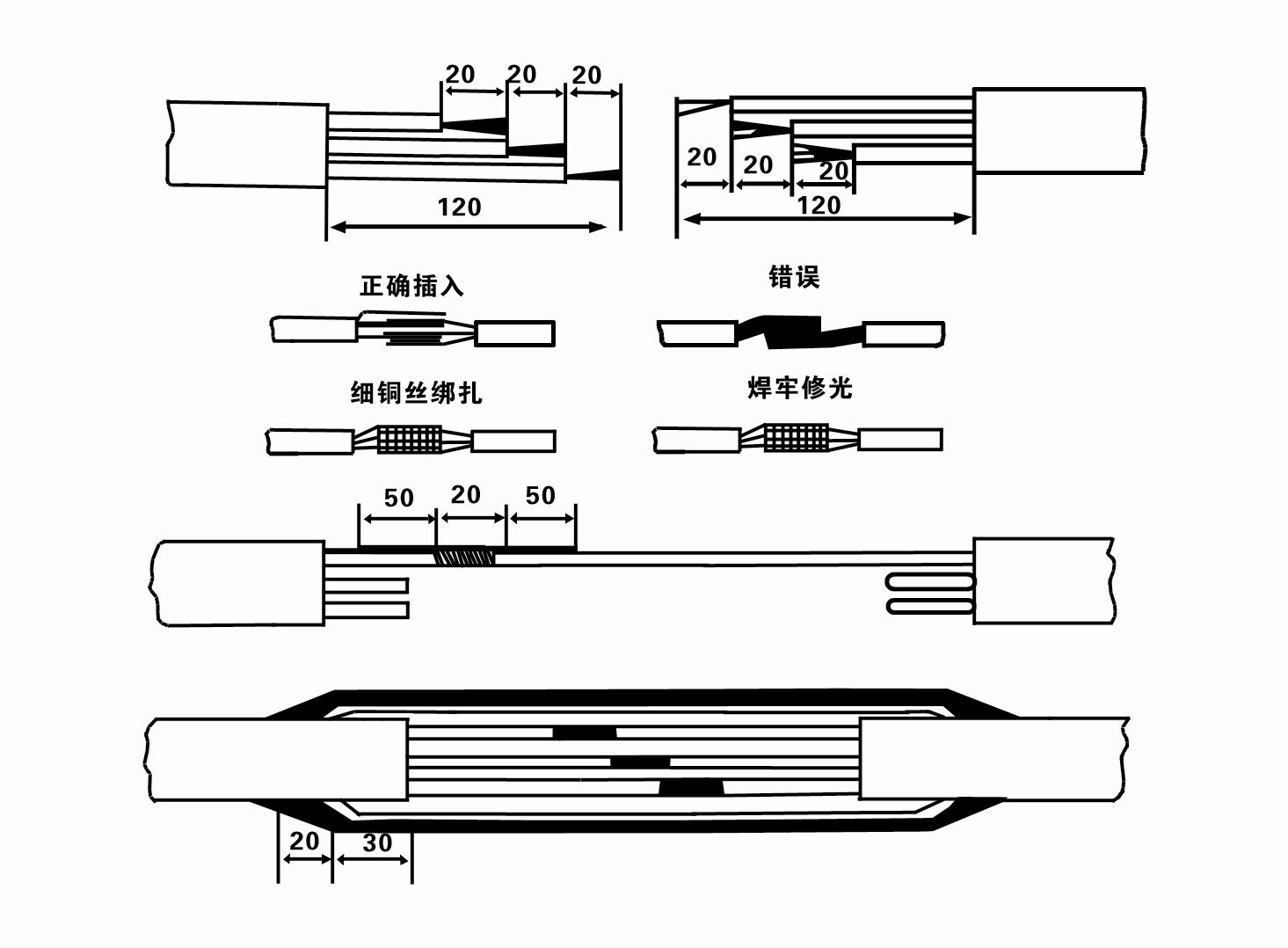
8. Use um multímetro para verificar se os fios trifásicos estão conectados e se a resistência CC está aproximadamente equilibrada.
9. Verifique se o circuito e a capacidade do transformador estão sobrecarregados e, em seguida, conecte a chave de proteção contra sobrecarga ou o equipamento de partida. Consulte a Tabela 2 para modelos específicos e, em seguida, despeje um balde de água na bomba d'água a partir da saída da bomba d'água para lubrificar os rolamentos de borracha da bomba e, em seguida, coloque a bomba elétrica submersível na posição vertical e estável.Inicie (não mais que um segundo) e verifique se a direção da direção é consistente com o sinal de direção. Caso contrário, troque quaisquer dois conectores do cabo trifásico. Em seguida, instale o filtro e prepare-se para descer no poço. Se utilizada em ocasiões especiais (como valas, valas, rios, lagoas, lagoas, etc.), a bomba elétrica deve ser aterrada de forma confiável.
(2) Equipamentos e ferramentas de instalação:
1. Um par de correntes de elevação para mais de duas toneladas.
2. Um tripé com altura vertical não inferior a quatro metros.
3. Duas cordas suspensas (cabos de aço) que podem suportar um peso de mais de uma tonelada (podem suportar o peso de um conjunto completo de bombas d'água).
4. Instale dois pares de grampos (talas).
5. Chaves, martelos, chaves de fenda, ferramentas e instrumentos elétricos, etc.
(3)Instalação da bomba elétrica:
1. O diagrama de instalação da bomba elétrica submersível é mostrado na Figura 2. As dimensões específicas de instalação são mostradas na Tabela 3 “Lista de Dimensões de Instalação da Bomba Elétrica Submersível”.
2. Bombas elétricas submersíveis com altura manométrica inferior a 30 metros podem ser içadas diretamente para o poço usando mangueiras e cabos de aço ou outras cordas de cânhamo que possam suportar o peso total de toda a máquina, canos de água e água nos canos.
3. As bombas com altura manométrica superior a 30 metros utilizam tubos de aço e a sequência de instalação é a seguinte:
①Use uma braçadeira para prender a extremidade superior da parte da bomba de água (o motor e a bomba de água foram conectados neste momento), levante-a com uma corrente suspensa e amarre-a lentamente no poço atéColoque a braçadeira na cabeça do poço e remova o corrente pendurada.
② Use outro par de braçadeiras para prender um tubo, levante-o com uma corrente suspensa a 15 cm de distância do flange e abaixe-o lentamente. Entre o flange do tubo e o flange da bombaColoque a almofada de borracha no lugar e aperte o tubo e a bomba uniformemente com parafusos, porcas e arruelas de pressão.
③ Levante ligeiramente a bomba submersível, remova a braçadeira na extremidade superior da bomba d'água, amarre o cabo firmemente ao tubo de água com uma fita plástica e amarre-o lentamente até que a braçadeira seja colocada na cabeça do poço.
④Use o mesmo método para amarrar todos os canos de água ao poço.
⑤Depois que o cabo de saída é conectado à chave de controle, ele é conectado à fonte de alimentação trifásica.
(4)Observações durante a instalação:
1. Se for encontrado um fenômeno de travamento durante o processo de bombeamento, gire ou puxe o tubo de água para superar o ponto de travamento. Se várias medidas ainda não funcionarem, não force a bomba para baixo para evitar danos à bomba elétrica submersível e ao poço.
2. Durante a instalação, uma almofada de borracha deve ser colocada no flange de cada tubo e apertada uniformemente.
3. Quando a bomba de água é abaixada no poço, ela deve ser colocada no meio do tubo do poço para evitar que a bomba funcione contra a parede do poço por um longo tempo, fazendo com que a bomba vibre e o motor varra e queime .
4. Determine a profundidade da bomba d'água até o fundo do poço de acordo com o fluxo de areia e lodo do poço. Não enterre a bomba na lama. A distância da bomba de água ao fundo do poço geralmente não é inferior a 3 metros (ver Figura 2).
5. A profundidade de entrada de água da bomba de água não deve ser inferior a 1-1,5 metros do nível dinâmico de água até o nó de entrada de água (ver Figura 2). Caso contrário, os rolamentos da bomba de água podem ser facilmente danificados.
6. A elevação da bomba d'água não pode ser muito baixa. Caso contrário, uma válvula gaveta precisa ser instalada na tubulação de água da cabeça do poço para controlar o fluxo da bomba no ponto de fluxo nominal para evitar que o motor fique sobrecarregado e queime devido a grandes vazões.
7. Quando a bomba de água está funcionando, a saída de água deve ser contínua e uniforme, a corrente deve ser estável (sob condições nominais de trabalho, geralmente não mais que 10% da corrente nominal) e não deve haver vibração ou ruído. Se houver alguma anormalidade, a máquina deve ser parada para descobrir a causa e eliminá-la.
8. Ao instalar preste atenção ao ajuste do fio terra do motor (ver Figura 2). Quando o cano de água for de aço, conduza-o pela braçadeira da cabeça do poço; quando a tubulação de água for de plástico, conduza-a a partir da marca de aterramento da bomba elétrica.
- 1. Após a instalação da bomba submersível, verifique novamente a resistência de isolamento e a condução trifásica do interruptor, verifique se o instrumento e a conexão do equipamento de partida estão errados, se não houver problema, a máquina de teste pode ser iniciada, e observe se as leituras do indicador do instrumento excedem a tensão e corrente nominais especificadas na placa de identificação após a partida, e observe se a bomba apresenta fenômeno de ruído e vibração, e coloque em operação se tudo estiver normal.
- 2.Após a primeira operação da bomba por quatro horas, o motor deve ser desligado para testar rapidamente a resistência do isolamento térmico, e seu valor não deve ser inferior a 0,5 megaohm.
- 3.Depois que a bomba for desligada, ela deve ser iniciada após cinco minutos para evitar que a coluna de água no tubo seja completamente refluída e cause corrente excessiva do motor e queima.
- 4.Depois que a bomba for colocada em operação normal, para prolongar sua vida útil, é necessário verificar regularmente se a tensão de alimentação, a corrente de trabalho e a resistência de isolamento estão normais. Se as seguintes condições forem encontradas, a bomba deverá ser desligada imediatamente para solução de problemas.
- 1 In the rated condition, the current exceeds 20%.
- 2 O nível dinâmico da água cai para a seção de entrada de água, causando água intermitente.
- 3 A bomba submersível apresenta vibração ou ruído intenso.
- 4 A tensão de alimentação é inferior a 340 volts.
- 5 Um fusível está queimado.
- 6 O tubo de abastecimento de água está danificado.
- 7 The motor's thermal insulation resistance is lower than 0.5 megaohm.
- Unit disassembly:
- 1.Untie the cable tie, remove the pipeline part, and remove the wire plate.
- 2.screw down the water bolt, put the water in the motor chamber.
- 3.remove the filter, loose the fixed screw on the coupling to fix the motor shaft.
- 4.screw down the bolt connecting the water inlet section with the motor, and separate the pump from the motor (pay attention to the unit cushion when separating, to prevent the bending of the pump shaft)
- 5.the disassembly sequence of the pump is: (see figure 1) water inlet section, impeller, diversion shell, impeller...... check valve body, when removing the impeller, use special tools to loosen the conical sleeve of the fixed impeller first, and avoid bending and bruising the pump shaft in the process of disassembly.
- 6.the disassembly process of the motor is: (see figure 1) place the motor on the platform, and remove the nuts, base, shaft head locking nut, thrust plate, key, lower guide bearing seat and double head bolt from the bottom of the motor in turn, and then take out the rotor (pay attention not to damage the wire package) and finally remove the connecting section and upper guide bearing seat.
- 7.unit assembly: before assembly, the rust and dirt of the parts should be cleaned, and the mating surface and fasteners coated with sealant, and then assembled in the opposite order of disassembly (the motor shaft moves up and down after assembly for about one millimeter), after assembly, the coupling should be flexible, and then the filter screen test machine. Submersible pumps shall be taken out of the well for dismantling and maintenance according to Article 5 after a year of operation, or less than a year of operation but two years of diving time, and the worn parts shall be replaced.
This product is a submersible pump, which is suitable for various water areas, such as home, agriculture and industry.In order to prevent the motor from freezing in winter, be sure to discharge all the water in the pump chamber, and roll and tie the cable well.In addition, a room without corrosive substances and gases and with a temperature below 40 °C should be selected for storage.When not in use for a long time, special attention should be paid to the rust prevention of the submersible pump.This product is exquisitely designed and convenient to use, which can help users efficiently deal with various water needs, and is an ideal choice for your home and industrial water.
- Impulsor
- Manga do eixo
- Luva do eixo de borracha
-
Anel de vedação
01 Tomada de água de poço profundo
02 Abastecimento de água em arranha-céus
03 abastecimento de água na montanha
04 torre de água
05 Irrigação agrícola
06 irrigação de jardim
07 captação de água do rio
08 água doméstica

